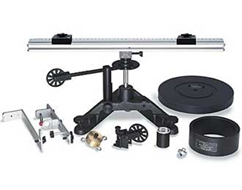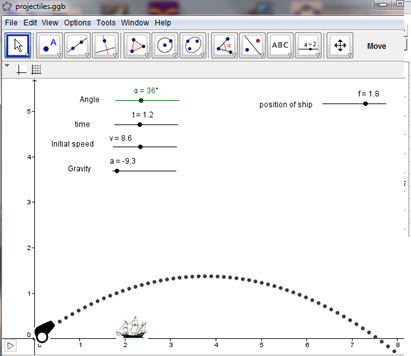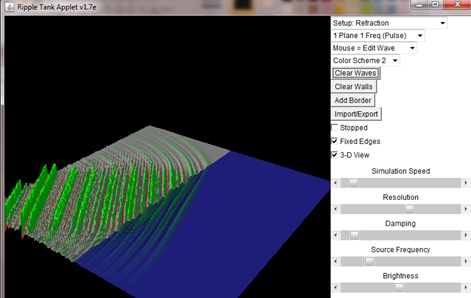Ideas for investigations
Apparatus based
These are all starting points for investigations, the idea being that a student would focus on a piece of apparatus, find out how to use it and carry out an investigation based on it. The report could also include the theory related to the investigation and some simulated activity. A great way to use some of those expensive pieces of apparatus gathering dust on top of your cabinets.
Dynamics Track
Conservation of momentum in collisions using video, motion sensors or light gates
Newton’s second law, masses and pulleys
Impulse using force meter to measure force and time for different collisions
Work and energy (Applying force to trolley and measuring increase in KE)
Energy conservation of a trolley rolling down an incline
Graphical analysis of motion using a motion sensor
Investigation of SHM of trolley and two springs
Rolling balls - many possible variables.
Rotational motion System
Conservation of angular momentum
Rotational inertia
Measuring centripetal force
Rotational inertia of a disc and rings
Rotational inertia of disc off axis
Rotational inertia of plasticine models
Optics bench
Snell’s law
Image formation in lenses
Image formation in curved mirrors
Diffraction grating
Single slit diffraction.
multiple slit interference
Diffraction by circular opening
The telescope
The microscope
Malus’ law
Aperture size and depth of focus
Inverse square law
Spectrometer
Measurement of emission spectra
refractive index
Multiple slit interference
Teltron tubes
Fine beam tube
e/m
electron diffraction
Critical potentials tube
Electrometer
investigating parallel plate capacitor
Potential close to a sphere
Charge distribution
Van de graaf generator
Action of points
optimum operating conditions
Spark length
Effect of humidity
electric force
radial field
Basic coil set
Self inductance
flux density
Falling magnet
mutual inductance
Energy losses
Magnet on a spring
Turns ratio
Coupled magnets on springs
B field sensor
Flux density due to solenoids and coils
Flux density around magnets
Use with slinky
Oscilloscope
How it works
AC experiments LCR circuits
Measuring sound
lissajou figures and phase
Stefan Boltzman apparatus
Stefan Boltzman law
Adiabatic gas law apparatus
Boyles law
work done by an isothermal process
Work done by an adiabatic process
Cycles
Heat capacity of a gas
measuring number of moles
different gases
Sonometer
driving the wire and resonance
fft investigation
changing wire
position of detector and driver
Projectile launcher
range and velocity
range and angle
effect of air resistance
ball size and range
Time of flight
Trajectory (with camera)
Maximum height and velocity
maximum height and angle
conservation of momentum in 2D
Ripple tank
Refraction due to change in depth
Diffraction through slits and around obstacles
Interference between two point sources
standing waves
Doppler effect
Physical system based
These are similar to the old style design experiments where the student was given some physical system like a coil of wire to base their research question on. The big difference is that the student is expected to show some understanding of the underlying physics (to score maximum marks) so shouldn’t be too ambitious, I have put a * by examples that maybe a bit too difficult to do well.
Play doh
Mechanics type experiments related to deformation.
Inelastic collisions
Depth of hole when pointed object dropped (*)
Impulse when dropped from different heights or different temperatures
Flattening when dropped from different heights (*)
Rolling of different sized balls and cylinders
Freefall acceleration of different sized balls
resistance of different pieces of play doh
temperature dependence of resistance
Balloons
Volume and pressure
Force between two charged balloons
frequency of note when tapped
loudness of sound when burst (*)
height of bounce and size (*)
acceleration of different sizes
resonance of different sizes (*)
use know to project balloon, distance knot pulled back and range
Filled with different gases
A wooden rod hanging from two strings
Speed at which it unwinds when twisted (*)
frequency and distance between strings
Frequency of angular oscillation and separation of strings
tension in strings and angle of rod
angular acceleration of rod and angular displacement
used as a battering ram
vary mass of rod and time period of various modes of oscillation
Strip of material
Twanged like a ruler on the bench
balanced as a bridge
balanced as a seesaw
balanced like a ladder
as a cantilever
used to project a mass
as a torsional spring
can vary lengths and angles or properties of the strip
Slinky
Transverse waves
longitudinal waves
as a solenoid
as an oscillating spring
rotated in circular motion
walking down the stairs (*)
as a suspension bridge (*)
Jelly
Modes of vibration of different sized cubes (*)
Refractive index of jelly made with different amounts of water, gelatine and sugar
Cut into lens shapes and used to verify the lens makers equation
deflection and refracting angle of different jelly prisms
used like ballistics jelly
electrical properties
absorption of light
elasticity of jelly made with different amounts of water and gelatine
Coils and magnets
Electromagnetic induction
strength of electromagnet
coils used as springs
transformers
falling magnet
vibrating magnet
Battery drill
power in and power used to lift object
back EMF
motor speed and voltage
Battery life and work done
heating when drilling
Flying pig
many variations on the conical pendulum theme
Musical instruments
Take your pick, many interesting investigations
Conductivity paper
investigating electric field for different electrode configuration
Temp dependence of resistance
modelling fluid flow
Simulations
Although it is possible to do an investigation purely with simulations I would prefer my students to link this with the real world by doing real experiments too. By simulating an experiment students can develop a better understanding of the underlying physical principles enabling them to understand the deviations of their experimental results from theory. For example a student doing an acceleration due to gravity experiment might wonder what effect air resistance would have on the motion of a ball. By building a simulation they can vary the air resistance and see how the motion changes. Most of the practical listed above can be simulated adding to the depth of the investigation. There are many ready-made simulations available on the internet but most of these are pre-programmed to demonstrate certain phenomena, these are excellent for demonstrating theory but for the purpose of the individual investigation I would prefer students to build their own simulations using one of the following options.
Algodoo http://www.algodoo.com/
Available to download free but also good to support the development with some cash.
- very colourful and easy to use
- can simulate pretty much all of the mechanics experiments
- vary gravity and air resistance, measure quantities and draw graphs
- build machines
- change properties of materials
- join objects with ropes and chains
- turn objects into water
- simulate fluid flow
- make objects transparent and shine lasers through them
- make lenses
- simulate gases with large numbers of particles

Interactive Physics http://www.design-simulation.com/IP/
This old classic is still around and well worth investing in even if you just use it for demos. Its quite expensive (about 1000 Euro for 10 users) so might be too expensive for some schools. Not quite as versatile as Algodoo, for example you it’s not so easy to interact with the simulation as its running, but a little bit easier to get started with.
- custom force fields
- electrostatics
- gravity
- strings and pulleys
- show vectors
- attach images

Excel
Excel can be used toplot graphs from equations by using formula to generate columns of data. The graphs can be animated by making time a variable linked to a slider. Changing the value of t with the slider will change the graph. Can be used for exponential decay, waves, motion, charging and discharging of capacitors. Most students will know how to use the basic functions.

Geogebra www.geogebra.org
Used for plotting graphs from equations. If time is one of the variables then the graph can be animated. Quite easy to set up simulations once the basic idea is grasped. Easier to use than excel since you don’t have to calculate values. One nice feature about Geogebra is that the simulations can be saved as Java applets and embedded into websites where they can be controlled on line.

Paul Falstad’s ripple tank http://www.falstad.com/
Paul Falstad has made a range of applets but the ripple tank is probably the most useful at this level. Much easier to use than the real thing. Can be used to demonstrate refraction, reflection, diffraction, interference, waves in closed pipes, Doppler effect. Particularly nice in 3D view.

phET
Loads of excellent simulations that can be used to increase understanding but not so good for using as the basis for an investigation. Showing that a simulation obeys the laws that it is programmed to obey is not particularly enlightening. However comparing a simulation to a real experiment to see how reality deviates from theory is. My particular favourites are:
- properties of a gas
- resonance
- electric fields
- body on a turntable
